#shpo
Explore tagged Tumblr posts
Text

Anthony, 25
“My dress is from Shop Untitled, top KNWLS London, shoes About Arianne, hat And They Loved Hats. I’m inspired by early and mid-20th-century styles. I’m also influenced by esoteric and spiritual art as well. I like to feel comfortable but also look my best, whenever I go out.”
May 14, 2023 ∙ NoHo
#nyc looks#street style#street fashion#outfit#vintage#street snap#boater hat#shpo untitled#knwls#about arianne
516 notes
·
View notes
Text
D-16 Charms are also on preorder!!


#transformers#transformers fanart#maccadams#maccadam#transformers one#tfone#transformers one fanart#tfone fanart#d16 tfone#tfone d16#transformers one d16#transformers one megatron#cogged d16#d16#megatron#tfone megatron#megatron fanart#acrylic charms#etsy shpo#epoxy charms#mtmte#artists on tumblr#transformers idw#transformers megatron
41 notes
·
View notes
Text
I can't fucking believe it dude
I'm gonna be an archaeologist!!!!
1 note
·
View note
Text
#etsy#smallbiz#macro#photography#black and white#skull#animal skull#print#home decor#etsy gifts#etsy finds#etsy seller#etsy shpo#etsy store#shop small
0 notes
Text


kept forgetting to post these idiots but uehm late valentine day i shpos?
72 notes
·
View notes
Note
Hi! I’ve seen you and other north american archaeologists writing about the pros and cons of archaeology, and I’m a bit curious as to how the archaeological system works. Who is responsible for doing excavations? Can anyone go out and dig? I’ve also seen some people mentioning being employed by private companies, are there non-government institutions, that does archaeology?
I’m from Denmark, and here it is only specific official museums, that are allowed to excavations anything. The universities aren’t even allowed.
Hi there, this is an awesome question and I'm going to do my best to answer it, but at the same time, my status as a relatively junior archaeologist is going to get in the way a little. I'm tagging @archaeologysucks and @archaeo-geek as two much more experiences archaeologists who work in the US and Canada, respectively.
Broadly speaking, there are three categories of archaeologists who work conducting excavations in North America:
Academics: folks who work at universities/in higher education who do archaeological excavation as research. They'll probably take whatever they find back to a lab to process it and write articles/books that will be published as part of their career. Academics mostly dig during the school breaks.
Cultural Resource Management/private practice: this is often done by private firms that are hired by companies/organizations when they need to conduct various kinds of archaeological survey (not always digging) before doing construction or maintenance. These folks also do lab work and research/publishing, but it's potentially less integral to their jobs whereas academics are expected to publish. Unlike academics, CRM archaeologists can work pretty much all year round, since they don't have teaching obligations.
Government archaeologists: State Historical Preservation Offices (SHPO) in each US state all have archaeologists who are tasked with conducting archaeology on state land. There are also archaeologists working in all sorts of different government offices, like the US Department of Agriculture and the National Park Service. There are also archaeologists who work for Indigenous peoples (Tribal Historic Preservation Offices) and within the US government to oversee compliance with the Native American Graves Protection and Repatriation Act.
This is all very broadly speaking, and I'm sure that there are nuances that I've missed. My experience is primarily within academia, but the majority of archaeologists work outside of academia doing many incredible things.
-Reid
104 notes
·
View notes
Video
youtube
Finding and recording sites is one of archaeology’s most essential functions, supporting both site preservation and understanding. Here, MVAC Research Intern Cindy Kocik describes how archaeologists find and report sites, from project planning to choosing fieldwork methods to documentation and reporting. Following applicable laws, adhering to ethical guidelines, and reporting sites to the State Historic Preservation Office (SHPO) all help to ensure that these irreplaceable cultural resources are treated appropriately, and that site information is preserved for future planning, preservation, and study.
44 notes
·
View notes
Note
PAT PAT PAT Stolas from Andre @a-hell-of-a-time

{{ L }} " I must say, if this is your method of courting me, it's rather a peculiar one. " He wasn't going to shpo the hand away, Stolas was desperate for physical attention.
2 notes
·
View notes
Text
My brother just refered to a dick as a "shponga shpoing" i never laughed so hard
4 notes
·
View notes
Note
A mysterious letter has found its way onto your desk.
Strange, you think, first and foremost. The Stellaronhvnters Predictions Office - or SHPO for short - has been closed all night. This morning when you came in for work as per usual, you had the very honor of unlocking the polished oak doors yourself.
So, pray tell, when did this letter arrive? How alluring.
You decide to put off any of your usual morning responsibilities for later. Shrugging off your blazer and sinking into your office chair, you get comfortable for taking the envelope in your hand. It's pristine white, no address or name scribbled etched onto the parchment. You snag your trusty letter-opener within reach and tear this sucker open.
Reading the first few lines, your stomach drops.
"To anyone that will listen, I need your help.
This joint Qownership-Yonarchy is unbearable. I haven't left the mines in days - I can only write on these ragged sheets of toilet paper after I stole an envelope and pen from an upper rank. It's so dark, and I miss my family.
Tyranny damns us all. Tomorrow, I plan on running, and I need a place to go. If this gets to the SHPO, I hope you'll take me in if I make it out unscathed. The stories of what go on in here are valuable, and I think you'd like to publish them.
Gamble, sleep, mine, praise the network, it's all I do. Forgive me, my hands are shaking too bad to continue.
Please anticipate my arrival; if I make it, that is.
Signed, Miner #7710"
(LMFAO THIS SI AMAZING????)
get back to the mines! whoever sent this letter! i am reporting this to Q!!!!!!!!!
2 notes
·
View notes
Text
Another TIM in jail for sexual offenses
By Genevieve Gluck February 13, 2024
A convicted rapist who identifies as a “woman” is back behind bars after breaching the conditions imposed on him to protect the public. Freddie Millar, 31, who also uses the name Xenia Jade-Millar and Xenia Woodward, was sentenced to 16 months in prison for violating a Sexual Harm Prevention Order (SHPO) and notification requirements.
Millar, of Northampton, was first convicted of rape in 2017 and served three years in prison for the crime. In 2020, he was again detained for misconduct, and incarcerated until September 2023. The conditions of his most recent release, as per the SHPO, legally required Millar, a registered sex offender, to disclose any new relationships, devices, and social media accounts to authorities.
However, during an unannounced check-up conducted by authorities in December of 2023, officers discovered an undisclosed laptop at his residence. Additionally, Millar had become involved in a relationship with a woman without alerting law enforcement.
A follow-up visit in January revealed that Millar had been operating multiple social media accounts under his various aliases — thus violating three stipulations specified in the SHPO.

Freddie Millar. Source: Facebook
On February 5, 2024, Millar appeared before Northampton Crown Court, where he was sentenced to one year and four months in prison.
Lead Investigator Detective Constable Will Corlett said in a press release: “Registered sex offenders are very closely managed by our team and I want to be clear that any breaches are dealt with robustly. We do not give second chances or ‘the benefit of the doubt’ – anyone who breaches their order is charged and brought before the courts with a view to sending them to prison.”
“I’m pleased to see Millar jailed as it means the streets of Northampton are that little bit safer,” Constable Corlett added. “I hope this case reassures the public with regards to how seriously we take offences such as this and shows the relentless determination of Northamptonshire Police to put as many people like Millar behind bars.”
Several comments appear to have been deleted from a post made on the Northamptonshire Police Facebook page announcing Millar’s sentencing.
On one Facebook account belonging to Millar, he confirms he identifies as transgender in a post dated December 28, 2023.
“Too [sic] everyone in the world listen to me right now, anyone who has a judge [sic] against me being a transgender come say it to my face,” Millar wrote. “This is just me being nice you don’t want to see me when I lose my sh*t cause trust me I’m dangerous when I’m angry.”

Millar’s sister commented on his post, suggesting that his threatening remarks were “not very lady-like.”
“I have known Freddie all my life and I struggle to believe this is reality, something Freddie struggles with,” she replied. Speaking directly to the 20 year-old woman Millar had become involved with, she added, “I wish you all the best, just be careful.”
The two women then exchanged in a brief back-and-forth, with Millar’s current girlfriend stating that “she is no longer a he and she is no longer Freddie… She is Xenia and why are you saying be careful? However, likewise I wish you all the best.”
During the course of their conversation, it was revealed that Millar had not undergone any surgical interventions. Millar’s sister asserted that she had “an opinion which I’m entitled to,” and insinuated that his history of sexual abuse had made her suspicious of her brother.
“Yes, you’ve done your time, but the nature of what you did, in my humble opinion, is unforgivable. If you are truly transgender, good luck to you… My one and only issue is what you’ve done. Maybe if I didn’t have a daughter I might think differently,” she stated.
Millar’s Facebook profile also suggests he has an estranged son whom he was trying to reestablish contact with.
While it is unclear which prison Millar will be sent to in order to serve the 16-month sentence, an unofficial national sex offender database established to inform the public has recorded his sex as male, and lists his offenses under the name Freddie Millar rather than Xenia.
#UK#Xenia Jade-Millar or Xenia Woodward is Freddie Millar#Male violence#Trans identified male sex offender
4 notes
·
View notes
Text
This is to hold me accountable.
I'm literally such a pig. I am always trying to fast and never make it more than 24hrs. And consistently break my rules. I'm going to Europe this summer and I will not be this fat ugly bitch when I go. I have 2 months to drop 50+
New rules, punishments, and rewards
Rules- no food after 8pm, no food before 11, not over 500cals per day, no fast food, laxitives once a week
Punishments- sh for going over Cals, miss laxitives I run to end of street and back, break fast means extra hrs added to the next day
Rewards- 1 good week= 50$ shpoing spree, 170= 100$ shoping spree 150= 200$ shopping spree
CW: 200
LW: 180
GW: 150
UGW: 13O
2 notes
·
View notes
Note
when does digging up a body go from grave robbing to science? cause I wanna dig something up know for science but im not sure if I can yet at least in span of time .

"I'm gonna have to stop ya right there dude. First off, if y'think you've found human remains, contact a local authority such as your police department. If it ends up bein' something of archaeological importance, an archaeologist or forensic anthropologist may be called in later. If you think you've found a cultural artifact and you're curious, I'd suggest leavin' it where ya found it, but taking a picture if yer so inclined. You could try n' ask a local museum or university about it. I've seen some with websites that have links to identifying finds or contact info for an expert.
"But to answer your question...well, it's somethin' we still debate in archaeology today! I've heard some make the joke that it becomes archaeology 'once no one cares about the remains anymore,' but that ain't necessarily true. It ain't about time, it's about permission. Grave robbers often just dig stuff up for money or for collecting. Us archaeologists gotta be professional about it - though plenty ain't - and we need to be conscious of permitting and allowance. Consent is king, kiddo!
"I speak mostly fer American archaeology, but here you gotta go through the State Historic Preservation Officer for a permit for any type of site. I'll use Texas as an example, but the Antiquities Code of the state of Texas requires a project to have a permit - and any other permissions necessary - before the archaeologist can even set foot on the land. The SHPO can reject a permit, too. Then it's a whole process of accreditation with other professionals, and then you can bring on student or volunteer workers. And these staff have to come on after signing contracts. Archaeology is waaaaaay more paperwork than it seems!"
((Alfred has forgotten to mention Tribal Historic Preservation Offices (THPOs) as well. A THPO is necessary if the find is potentially indigenous in origin. If you really want to try your hand at digging, that's perfectly fine! Try your backyard (with permission) first. You can look up or ask us how us dirt surgeons set up units and try to take a methodical approach to survey and excavation. But permission, I would say, is the biggest takeaway here.))
#ask archaeology boy#archaeologyfjones#from the editor's desk#got a bone to pick#hetalia#hetalia ask blog#aph america#hws america#alfred f jones
40 notes
·
View notes
Text
#etsy#smallbiz#photography#grand prismatic spring#yellowstone#yellowstone national park#wyoming#travel#hiking#landscape#nature#print#home decor#etsy gifts#etsy finds#etsy seller#etsy shop#etsy store#shpo small
0 notes
Text
So @matan4il asked me about the NPS theme studies and whether there had ever been one done for Jewish sites in the US.
I wanted to answer this publicly because the answer is very simple, but there's paths for moving forward.
So the answer is: no. There's no Jewish theme study, and there never will be, just as there's no Christian or Muslim theme study. Because it's a US Federal program, the NPS won't directly fund this type of work on religious communities, and they also won't list properties that are only significant for their ties to a religion. For these purposes, the NPS has traditionally considered the Jewish community to be primarily a religion, even though we all know it's not that simple.
I don't see this ever changing, without a Supreme Court challenge that no one's going to bring. Faced with an unenviable choice, the NPS has come down heavily on the side of "now no one gets the funding". It sucks, because religious life is inextricable from the human experience, but also I get it, because I too don't want the Baptists to have the power to list all their churches.
Does that mean there are no properties significant to Jewish Americans on the National Register? Of course not. Typically, sites related to Jewish history or culture have been listed under Criterion A for Social History or Ethnic Heritage: Other, Criterion B for a notable person connected to the site, or Criterion C for architecture. I've heard some mutterings that as of 2021 they were accepting Ethnic Heritage: Jewish as an area? But I'm confident that as of 2018 they weren't. Synagogues (and all religious buildings) require an extra level of scrutiny, but many are listed; I just ran across one that was listed under Civil Rights, which is the way that many churches, especially Black churches in the South, are listed.
So we know we can get the properties listed if we can get the work done, but how do we get the work done, if the NPS can't/won't do it?
This kind of scholarship is basically not like any other kind of writing, but the National Register is best understood as a series of documents developed by the 59 SHPOs* and moderated by the Federal government. On the day to day, it's people at the state level doing the majority of the work, and in the context of the National Register, the states are typically more willing to treat Jewish people as an ethnic/social group**. The NPS produces the big theme studies, but the states are writing contexts and MPS documents all the time.
In terms of Jewish-American history, we do have at least one good example to look at: linked from the NPS's page about Jewish American Heritage Month is the Historic Synagogues of Connecticut Multiple Property Submission. This submission is from the 1990's and would be much longer now, but it does a solid job of providing a basis for further work, and it has been used to spin off several nominations. States often use each other for reference, so just because a study or MPS is for, say, Kentucky doesn't mean that Tennessee can't make use of it.
The other good thing about working with the states is that the Feds are very slow and the states are often much faster, and there is grant money that the states can exploit for this kind of work. If you care about seeing this work done, contact your SHPO and tell them.
And I feel obligated to say this because I work in the South, but: just because your governor and/or state legislature is a fucking tire fire, don't write off your SHPO. Your state legislature does not care about the SHPO or the National Register. Trust me on this.
It's also important to remember that National Register listings are simultaneously free and very expensive. Anyone can write a nomination as long as they can get it to the correct standard, but consultants who work on them charge loads. Nobody's learning this writing in college, so if you're in a place where you have a lot of time, see if there's a void you can fill. Cultural organizations may have properties that they've identified but haven't had the money to write nominations for, and they may have the capacity to administer a grant that you don't (lil plug for the ISJL and their work at Temple B'nai Israel in Natchez, listed in 1979).
How to handle groups like Jewish people is a very sticky issue at the Federal level, and I don't envy the people who had to make those decisions at the NPS. I also don't love that Jewish history isn't going to get the same treatment as the other theme studies. But preservationists have many tools, and using the right ones for the right job is part of making sure the story gets told.
-
*State Historic Preservation Offices. Federally funded offices overseeing, among other things, the NR process. There's one for all 50 states, DC, PR, the other territories, and the Freely Associated States.
** It's not just Jewish people, there's a big-ass Mormon religious sites MPS, but the states have generally been more empowered to treat religious groups as actors in social history and not religions because *waves hands around* law
#national park service#s is working#please note: I would love to be wrong about this#I would just be delighted if they announced a Jewish theme study tomorrow
12 notes
·
View notes
Text
Here's This Year's List of the Most Endangered Historic Places in the U.S.
— May 1, 2024 | Neda Ulaby

Built in 1921, the New Salem Baptist Church served Black coal miners and their families in Tams, West Virginia. Cody Straley/WV SHPO/National Trust for Historic Preservation
There's a lonely old church in the mountains of West Virginia that holds a hidden history. Black coal miners in a segregated camp worshipped there starting in the 1920s. Now, the New Salem Baptist Church is listed as one of America's 11 most endangered historic sites.
The National Trust for Historic Preservation has released a list highlighting such places every year since 1988. Carol Quillen is the organization's new president and CEO. Trained as a historian, she was the first female president of Davidson College in North Carolina.
"I studied the past largely through texts, not places," Quillen told NPR. "And the difference between imagining one's relationship to the past through experiencing a place and reading a book in a library is really profound. So I love the way these places, which themselves hold layers and layers of stories, and invite us in the present to connect our stories to the ones these places hold."
Quillen said the push to preserve the New Salem Baptist Church came from a white Catholic woman whose father was the town's milkman. She enlisted not just the descendants of the church's original parishioners but also local ATV riders who could see and admire the church from a mountain trail.
"I love stories like that where a preservation project can mobilize folks who normally wouldn't encounter one another to work together on something significant to all of them," Quillen said. "And in that work, transform what the place can mean."
Black residents of Eatonville, Fla., have been trying to preserve their hometown for decades. One of the first self-governing all-Black towns in the United States, Eatonville was immortalized in the classic 1937 novel Their Eyes Were Watching God by Zora Neale Hurston. The legendary Harlem Renaissance writer and anthropologist once described her hometown as "the city of five lakes, three croquet courts, 300 brown skins, 300 good swimmers, plenty guavas, two schools and no jailhouse."
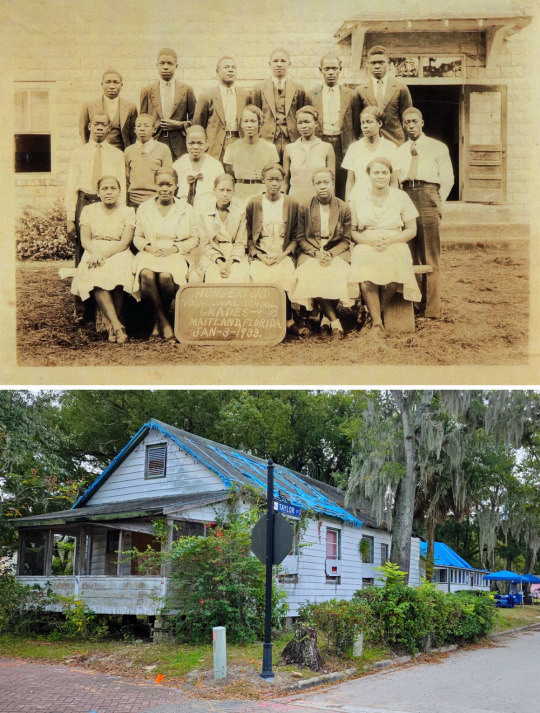
Top: Hungerford Vocational School students in 1933 in Eatonville, Florida. Preserve the Eatonville Community Archives/National Trust for Historic Preservation
Bottom: Thomas House is the oldest structure in Eatonville and the original site of the St. Lawrence African Methodist Episcopal Church. Melissa Jest/National Trust for Historic Preservation
In a 2015 NPR story reported by Renata Sago, residents dreamed of an Eatonville reborn as a year-round heritage destination and remembered it as a refuge during the days of Jim Crow.
"We didn't lock our doors and kids could go out and play," recalled an elderly resident, Maye Saint Julian. "And everybody knew everybody. And all of these people that we honor so — James Brown, B.B. King, Lionel Hampton — these people came to Eatonville on a regular basis."
Ideally, Eatonville and many other sites on the list, such as the Cindy Walker House, could eventually become better-known cultural destinations. Located in Mexia, Texas, the ramshackle white frame structure was where a remarkable, unsung figure in country music lived for many years. Walker was one of the few female songwriters of her era. She wrote country standards and number one hits for Roy Orbison, Merle Haggard, Elvis Presley and more.
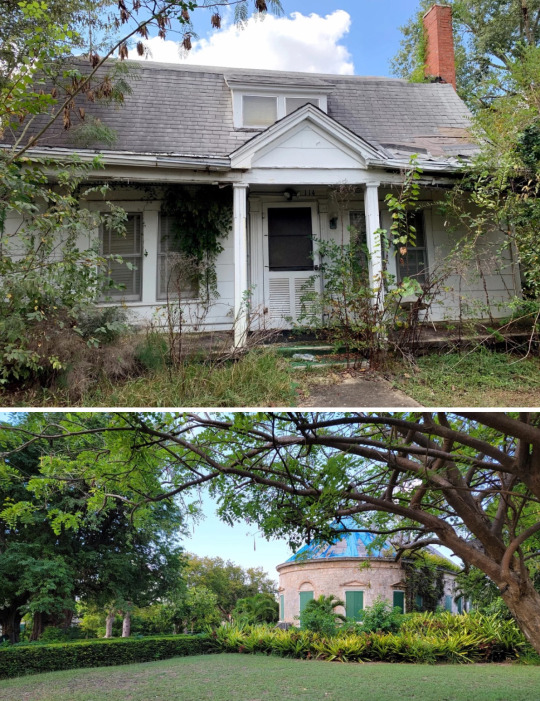
Top: Country singer Cindy Walker's home in Mexia, Texas. Cindy Walker Foundation/National Trust for Historic Preservation
Bottom: Tarps cover hurricane damage on the roof of the Estate Whim Great House. St. Croix Landmarks Society/National Trust for Historic Preservation
After she died in 2006, Walker's house was left abandoned. A handful of fans and heirs formed a foundation in her honor and purchased it in 2022.
"They found all kinds of things there," Quillen said. "They found her typewriter. They found her country music awards. They found songs that no one had ever heard before." One of those songs was a lost demo, called "Tennessee Rain," that can be heard in the audio version of this story.

This press photo of country singer Cindy Walker was among many never-before-seen photos recovered from the home. Cindy Walker Foundation/National Trust for Historic Preservation
Over the past three decades, the National Trust has seen some triumphs with its annual list of endangered places. Dozens of them have been saved, including the Antietam National Battlefield in Maryland, which narrowly missed becoming the site of a shopping mall, and Little Rock Central High School, where young Arkansas students helped overturn a legacy of legal segregation in 1957.
Now established by Congress as a National Historic Site, it's still a working public high school and a center for education about the country's civil rights.
"We don't want to spray these sites with ScotchgarEd, you know, and roll them off," Quillen said. "We really want to reinvigorate them so that they're active, exciting places for people to go so that they can continue to bring people together now and long into the future."
Here are the rest of the endangered historic places on the list this year:
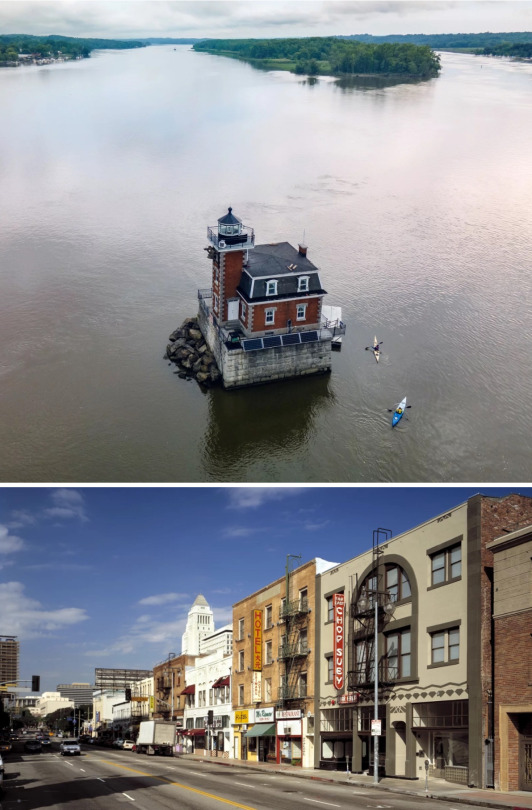
Top: The Hudson-Athens Lighthouse is one of two "middle-of-the-river" lighthouses left standing on the Hudson River. David Oliver/National Trust for Historic Preservation
Bottom: 1st Street is the major thoroughfare in Los Angeles' Little Tokyo. Kristin Fukushima/National Trust for Historic Preservation
Estate Whim Museum, Frederiksted, St. Croix, U.S. Virgin Islands: "Established during the colonization of St. Croix by Denmark, Estate Whim was a plantation producing cotton and sugar for export. The lives and legacies of those enslaved by plantation owners and those who continued to labor there for meager wages for a century after emancipation are inextricably tied to the site, which now hosts a museum, library and archives, and public programming. Repeated hurricanes have damaged many of Estate Whim Museum's historic buildings and structures."
Hudson-Athens Lighthouse, Athens, N.Y.: "Opened in 1874, the Hudson-Athens Lighthouse used to be one of several 'middle-of-the-river' lighthouses on the Hudson River. Now, it's one of only two left standing. However, due to erosion and other preservation challenges, engineering reports indicate the building is at risk of collapse within three years if no action is taken."
Little Tokyo, Los Angeles, Calif.: "Little Tokyo is one of only four remaining Japantowns in the United States and one of the oldest neighborhoods in Los Angeles, but its unique character is endangered by large-scale development and transit projects and displacement of legacy businesses and restaurants."
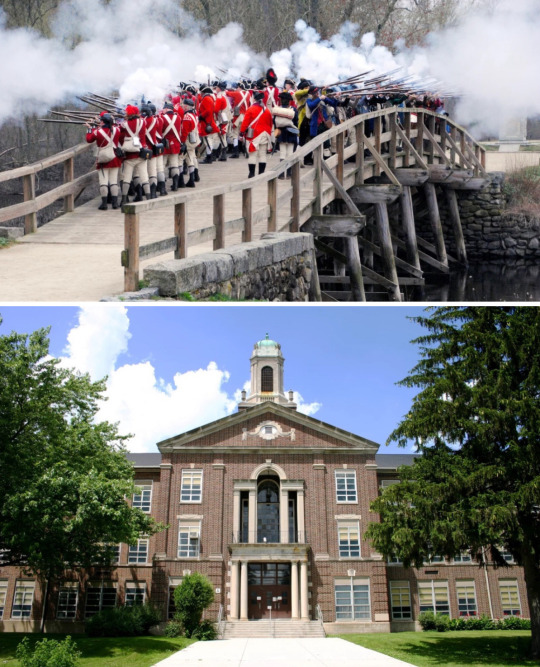
Top: Minute Men and British reenactors fire a musket salute off the North Bridge at Minute Man National Historical Park. Neil Lynch/National Trust for Historic Preservation
Bottom: Theodore Roosevelt High School in Gary, Ind., in 2015. Tiffany Tolbert/National Trust for Historic Preservation
Minute Man National Historical Park, Walden, and nearby landmarks, Massachusetts: "Minute Man National Historical Park and the nearby areas of Concord, Lexington, Lincoln, and Bedford are home to places of great significance in American history, including Walden Pond and Woods and the preserved homesteads of authors and environmentalists: Little Women's Louisa May Alcott, Nathaniel Hawthorne, Ralph Waldo Emerson, and Henry David Thoreau. A proposed major expansion of nearby Hanscom Field airport could significantly increase private jet traffic, leading to increased noise, vehicular traffic, and negative environmental and climate impacts."
Roosevelt High School, Gary, Ind.: "Theodore Roosevelt High School in Gary was built in 1930 specifically to serve the educational needs of Black Americans and has graduated notable alumni including professional athletes, well-known actors, and members of The Jackson 5. The school has been unoccupied and deteriorating since 2019."
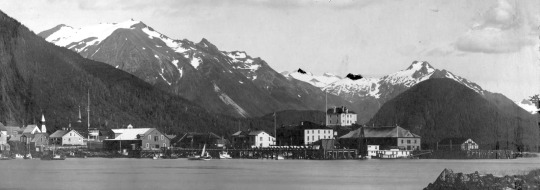
A view of Sitka Indian Village from across Sitka Harbor, circa 1900-1930. Library of Congress/National Trust for Historic Preservation

The Sitka Tlingit Village in 2024. James Poulson/National Trust for Historic Preservation
Sitka Tlingit Clan Houses, Sitka, Alaska: "The Sitka Tlingit Clan Houses in southeast Alaska are critically important to both the history and the future of the Lingít (commonly spelled in English as "Tlingit"). For many years, the matrilineal clan structure of multigenerational extended families living together in clan houses was discouraged in favor of the Western practice of living with nuclear families. Today, only eight of the original 43 clan houses remain and even fewer still function as clan houses in the traditional way."

Tangier American Legation's main courtyard. Tangier American Legation Institute for Moroccan Studies/National Trust for Historic Preservation
Tangier American Legation, Tangier, Morocco: "In 1821, the Tangier American Legation in Morocco was gifted to the United States by the Moroccan Sultan as a token of friendship, becoming the first American public property located abroad, and subsequently served as a U.S. diplomatic mission for a record 140 years. Now a cultural center, museum, and research library, the Legation is in urgent need of structural stabilization and repairs following the recent collapse of an adjacent building."
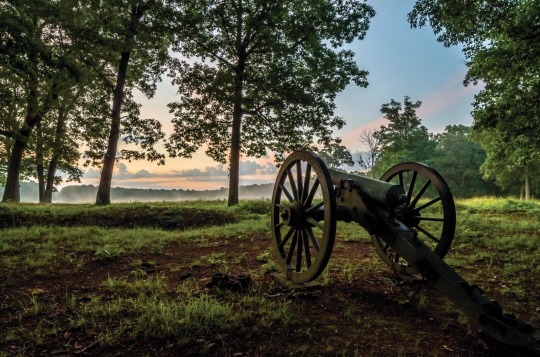
A cannon on the Wilderness National Military Park. Lori Coleman/American Battlefield Trust/National Trust for Historic Preservation
Wilderness Battlefield Area, Orange County, Virginia.: "The Battle of the Wilderness marked a pivotal turning point in the Civil War, but today, not all the historically significant landscape is protected. Proposed large new developments, including millions of square feet of industrial data centers and thousands of homes, may negatively impact important historic sites and landscapes and degrade the visitor experience."
#All-Black-Towns#Cindy Walker#Citka#The National Trust For Historic Preservation#Eatonville#Zora Neale Hurston#Historic Preservation#The Most Endangered Historic Places | U.S. 🇺🇸#NPR.ORG
0 notes